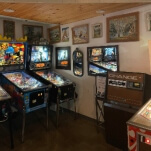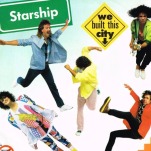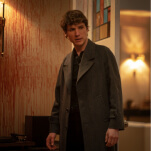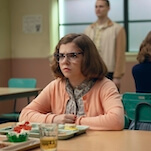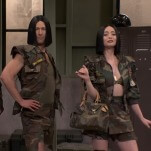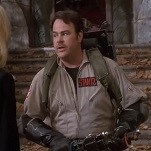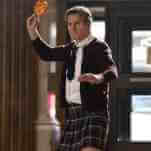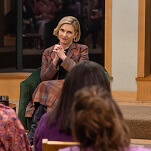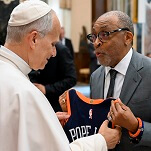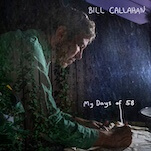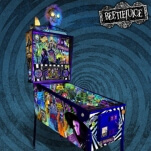A few days ago, while blitzing my way through the back half of The Mindy Project’s second season, I realized something: The show was as formless as ever, and many of the characters lacked even the most basic of definitions. But when any of those characters, no matter how poorly conceived, entered a scene with Chris Messina’s Danny Castellano—the irascible but lovable grump who plays the protagonist’s main love interest—they immediately snapped into focus. It didn’t matter which character it was, either. Even the ones I liked least were improved by spending a little time with Danny. And the more I watched the show, the more I realized why that was: Danny pushed the characters’ buttons. He poked and prodded at them. Even if he was their friend, he wasn’t always easy to get along with. The realization was bracing, and I quickly found myself mentally cataloguing the network sitcoms I was still watching, only to realize something fairly huge: Too often, the American sitcom is being strangled by a lack of conflict.
As a thought experiment, consider this: How many times have you watched an episode of a sitcom—especially a single-camera sitcom—where the episode featured the characters getting mildly perturbed at one another, blowing things out of proportion, then forgiving each other because they realized their friendship was more important than their petty grievances? And how many times has that episode ended with a slow pull-back from the whole group laughing and chatting together while they celebrate the maintenance of the status quo, often with jaunty pop music taking over the soundtrack? Obviously, I watch a lot of TV, so the thought of how often this particular ending pops up may have occurred to me more readily. But I’m willing to bet if you’re any kind of TV comedy fan, you’ve thought of a bunch of examples, both on shows you love and shows you can take or leave.
I’m not even saying there’s anything necessarily wrong with this ending. Hell, that ending roughly closes out Community’s “Remedial Chaos Theory,” and that’s one of my favorite episodes of the past many years. (At least there, the show has the decency to admit some people will always feel outside the circle of love.) I point to it more as an example of how the need to have everybody like each other has taken over the broadcast network sitcom, almost to a fault. If the characters don’t like each other, the thinking goes, then the audience might not like them either, and if the audience doesn’t like them, then it might tune out. Particularly in the wake of the monster success of Friends, too many networks—particularly ABC, NBC, and Fox—seem intent on recapturing that show’s low-key, hang-out vibe, on coming up with shows where the characters become a kind of friend group proxy that we look forward to spending time with. What this ignores is both how much of an anomaly Friends was in TV history and how much that show was driven by introducing deep rifts between the characters that were not so easily solved, before uniting them again after putting in the work. What it ignores, in other words, is conflict, the bedrock of all narrative.
Let’s try another example. In recent weeks, there’s been a bit of a push from various writers to try to figure out just why The Big Bang Theory is not only TV’s biggest hit but TV’s biggest hit by a staggering amount. (It’s pulling in numbers that would have been respectable 20 years ago, which is astonishing in the age of DVR.) These efforts were often impressive—Vulture even made infographics!—but I think they missed what makes The Big Bang Theory so popular. For all its faults (and they are frequent and glaring), Big Bang is the only TV sitcom on right now that is about a strong, central conflict between characters, one that can’t be easily solved so much as chipped away at. The center of almost every episode involves the characters defining themselves in opposition to Sheldon somehow. As originally conceived, The Big Bang Theory was a kind of riff on The Odd Couple, with the everyman having to deal with the fastidious fussbudget to the extreme, and the longer it’s run, the more that’s sunk into the foundations of the show. Everybody on The Big Bang Theory likes Sheldon enough to tolerate him. But they, and the audience, know him well enough to also roll their eyes at the thought of having to deal with him.
Think about the other sitcoms out there. Is there another show built around that strong and essential of a conflict? Not really. The central thesis of the hang-out sitcom—all of these good friends are friendly with each other—has infected every other form of sitcom, including family sitcoms and workplace sitcoms. Community sort of tried to build a strong central conflict with Pierce, but he was way off on the edges of the ensemble. (Tellingly, the show’s fans—even some critics—spent much of their time wondering why anyone would hang out with the guy.) New Girl had a bit of this in its early going with Jess and then later on with Schmidt, but both characters were softened and smoothed out to fit more readily into the ensemble vibe. (It’s also telling that the time New Girl looked like it was going to be a monster hit perfectly coincides with the episodes where everything was about all of the characters coming into conflict with and pushing back against Jess. This had the unintentional effect of weakening the lead character, and the show got much better once it turned into more of an ensemble show. But it also fell off dramatically in popularity.) And Parks & Recreation has proved so conflict-averse that it’s turned Ron Swanson—a character deliberately created to push the lead character’s buttons—into her best friend.
I love all three of the shows listed in the paragraph above, but taken in tandem, along with lots of others, from Happy Endings to Cougar Town to How I Met Your Mother to Modern Family to [fill in the blank], to say nothing of the host of hang-out shows coming in the fall, the overwhelming sense becomes somewhat exhausting. The trend is even more glaring when considering TV history, where the Big Bang example—an ensemble packed with conflict, usually directed toward one individual who drives everybody a little nuts—is much more prevalent, particularly in the biggest hits. I Love Lucy, All In The Family, Everybody Loves Raymond, The Office—all were built off this basic principle. Cheers, perhaps the most perfectly constructed sitcom ever made, had two of them, in Sam and Diane, who not only drove each other crazy but drove everybody else in the bar crazy, depending on which of the two was talking to any given supporting character. In its own way, Cheers dug into issues of how American class was as much about presentation as economics, then built those ideas into every member of the ensemble, even after Diane left.
The principle even applies to less obvious examples than the ones listed above. Mary Richards might have turned the world on with her smile, and she was basically a good person, but her interactions with the men of the WJM newsroom both subtly tweaked male/female power struggles and the notion of women in the workplace. Just having Mary sitting at her desk in the newsroom suggested oceans of conflict all of the characters had to navigate simply by being around each other. Or take one of the biggest sitcoms of the ’60s, The Beverly Hillbillies, or Arrested Development, a beloved modern sitcom with little in common other than this one thing: Both are about unlikely families placed into conflict with the world around them. Most of Bob Newhart’s shows flip this script, making Newhart the sole sane man amid a bunch of oddballs. Green Acres also follows that basic template. Seinfeld’s central foursome might have been mostly pleasant to each other (though this was touch-and-go every week), but they struggled constantly with the world at large, the peculiar philosophies of the characters not always making sense outside of their usual bubble.
The one area in modern sitcoms that seems like a way to sneak conflict into a story is setting, but even here, too many shows are dropping the ball. The most classic example of this is probably M*A*S*H, where the characters’ conflicts (which did exist) paled in comparison to the fact that they were in the middle of a war zone. (Another solid ’70s example of setting and premise informing the conflict at all times would be Barney Miller.) There are a handful of shows on the air trying to do something like this right now. The most notable example is likely Fox’s freshman Brooklyn Nine-Nine, which is a good show but also a show that seems to turn away from deeper conflicts whenever possible, playing up an endless, potentially harassment-ridden sexual pursuit as just more wacky fun. The crimes solved are rarely serious, and if the show had a character everybody else was supposed to be reacting to—probably Andy Samberg’s Jake Peralta—the series did everything it could to fit him snugly into the ensemble as quickly as it could. The Middle is also able to do a bit with setting-based conflict, situating everything that happens in the world of the working class, where the conflict is inherent in just trying to scrape by. The loss of Enlisted is felt even more acutely here. That was a show that understood the inherent conflict in military life, in brothers who had strained their relationship growing up. Naturally, it was canceled by Fox, at least partially, because, in the words of Kevin Reilly, it was “neither fish nor fowl,” a comedy that dared to have darker, more dramatic moments ridden with conflict.
A part of me wonders if this is a natural offshoot of the shift from multi-camera sitcoms being the dominant form to single-camera sitcoms being the dominant form. In some ways, conflict, when presented realistically in a single-camera sitcom, becomes too real. The multi-camera sitcom has the protection of the proscenium arch, of the fourth wall, things that human beings have practically coded into our DNA to subconsciously reassure us that a story is being told. A single-camera sitcom can get up close to its subjects. It can invade their space. It can provoke and push and prod, and all of that has a certain cost in having the characters confront not just each other but, subconsciously, us. The fourth wall remains mostly rigid in the multi-camera sitcom, a comfortable separation. The single-camera sitcom thins that fourth wall by putting us in the action. And that makes unsolvable conflicts in these sorts of situations all the more complicated to deal with. (Again, think of the reaction to Pierce on Community and how often creator Dan Harmon was asked, point-blank, why anyone would hang out with someone so mean. The Big Bang writers almost never get that question about Sheldon.)
It’s perhaps worth noting here that while cable comedies are better on average than network sitcoms, they don’t get a pass either. FX’s Archer likely comes closest to the ideal of “strong personality other personalities are defined against,” but that description also fits just about everybody on that show. (Another possibility in the animated sphere: Rick And Morty.) HBO’s Girls also fits this bill somewhat, but it also follows some of these ideas to their logical conclusion and introduces rifts between the characters that will likely lead to permanent separations as the show goes on. It’s Always Sunny In Philadelphia falls somewhere between the Beverly Hillbillies and Seinfeld models, with a ridiculous central ensemble dealing with the “real” world. Cable, however, also doesn’t have to deal with 22 episodes per year, when it can be much more tempting to make sure everybody likes each other at the end of the episode.
There has always been a place for gentle humor in the sitcom world. What was The Cosby Show, but the very mildest of huge hits, a chance to hang out with the best family in the world and wish they were your own? Some of the same goes for The Dick Van Dyke Show, which mostly left its conflicts understated (though they were present). And there’s also room for shows where the conflict is primarily between the characters and themselves. At its best, Community did plenty of this, and Parks & Rec was also at its strongest when Leslie Knope was at once her own greatest ally and her own greatest enemy. More recently, New Girl’s terrific second season sent every character on a path that left them struggling against themselves, before the much faultier third season left them dangling in the wind and spending super fun times hanging out together.
There’s even room for the hang-out show when done well. Friends was certainly a great TV show, but it also understood that to keep things going, it would have to introduce relationships laden with conflict that would evolve and change. The show ran Ross and Rachel into the ground, but it also got every single drop of humor it could out of it, and the same could be said for almost any character pairing on the show. The conflict between Phoebe and Joey, say, was very different than that between Joey and Chandler, and the show understood perfectly how to exploit those conflicts for both maximum comedy and drama.
It’s been obvious for years now that networks would desperately love to find another Friends, yet they continue to be stymied when the mass audience tunes out or returns to Sheldon Cooper and company. What they increasingly seem to not understand is that the center of a story can never be simply people we want to spend time with. The center of a story must always be something difficult, something that ideally pits two people against each other or, at the very least, pits characters against the world they live in or against their very selves. The center of a story must always be conflict, and on a TV show, it needs to be a conflict that will exist week after week, year after year, decade after decade. There’s a place for hang-out sitcoms where the conflicts are minor and easily dismissed—particularly when they’re well-done—but increasingly, they’re all American sitcoms have to offer, and they’re choking everything else out. It’s time for sitcoms to remember that the easiest way to be funny is the same thing as the easiest way to be dramatic: Up the stakes.








